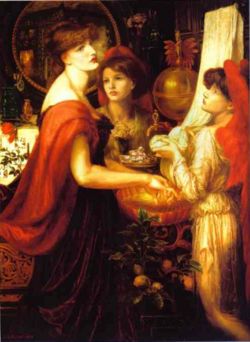La Bella Mano
From Delaware Art Museum Website:
Our first impression of La Bella Mano is of a superabundance of “things,” crowded into a shallow space and even more compressed by the convex mirror’s reflection of a fire, shelves of silver and ceramics, and a canopied bed. Leaves, carvings, lace, feathers, flowers, jewels and gold are all richly colored and sensitively textured. But the visual center is the woman’s face, pale and lost in her response to something she sees or hears from beyond this exotic room, or maybe from within herself. Her two attendants are physically sensual in an androgynous way, but their wings identify them as supernatural creatures. They are a bridge between tangible and intangible worlds, as angel-figures usually are in art and mythology. They tell us that, despite the appearance of a Victorian boudoir, wherein a lady completes her toilette, probably in anticipation of the man who will join her, this is an other-worldly place. External experience, from water to fragrance to flickering light, coexists with the internal experience manifested in the woman’s expression.La Bella Mano is typical of many Rossetti paintings of the last fifteen years of his life. Rossetti portrays a woman as the amalgam of the physical and spiritual aspects of love. As such, she is more than a woman, more even than the “ideal woman.” Like Beatrice, the poet Dante’s beloved, she is a complex symbol of the fusion of body and spirit, of the soul’s pilgrimage to God, of perfect love, of the soul itself. She exists suspended in time. Her features represent Rossetti’s concept of ideal beauty, perfected over several decades. Her symbolic role evolved from several sources, most notably from Rossetti’s immersion in Dante’s poetry and from his sympathy with the Romantic quest for the unattainable ideal.
Rossetti wrote a sonnet for La Bella Mano after he finished the painting:
O lovely hand, that thy sweet self dost lave
In that thy pure and proper element,
Whence erst the Lady of Love’s high advent
Was born, and endless fires sprang from the wave:-
Even as her Loves to her their offerings gave,
For the the jewelled gifts they bear, while each
Looks to those lips, of music-measured speech
The fount, and of more bliss than man may crave.
In royal wise ring-gift and bracelet-spann’d,
A flower of Venus’ own virginity,
Go shine among thy sisterly sweet band;
In maiden-minded converse delicately
Evermore white and soft; until thou be,
O hand! heart-handsel’d in a lover’s hand.
